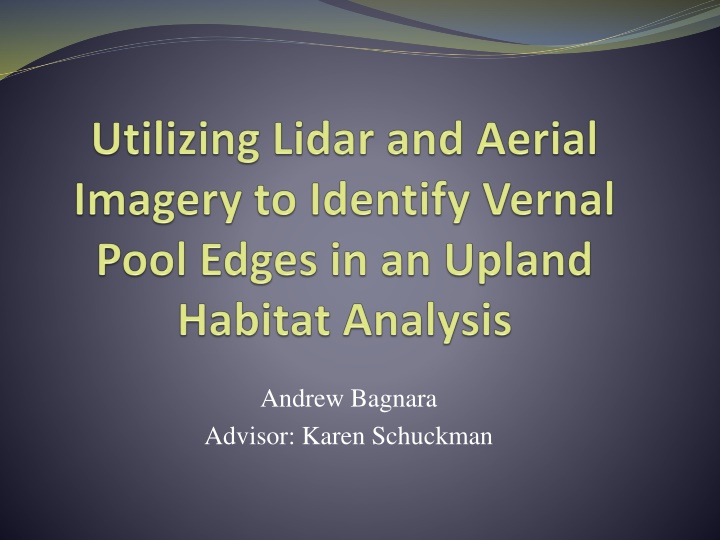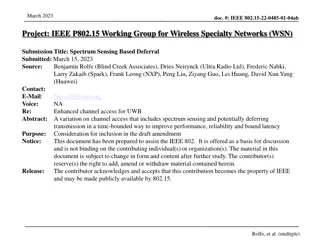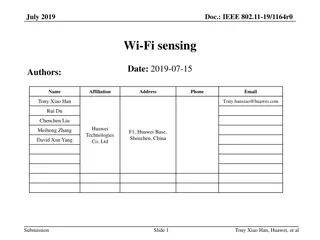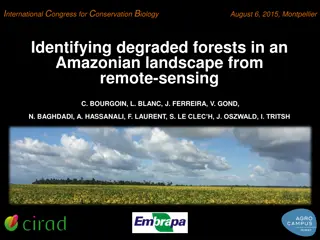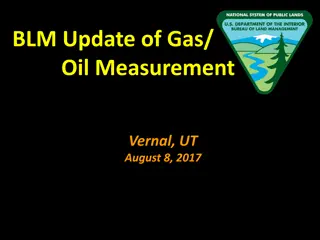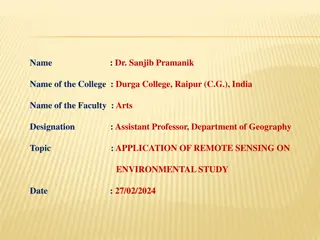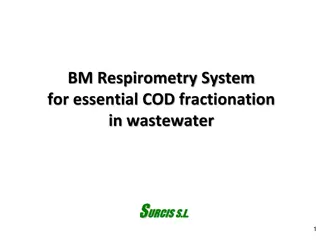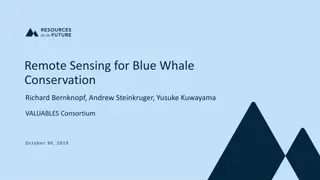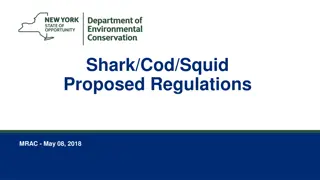Utilizing Remote Sensing for Identifying Vernal Pools in Cape Cod
Utilize new remote sensing and LiDAR technologies to identify certified and potential vernal pools in Cape Cod. Visualize hydro edge boundaries, compare to species migration metrics, and assess developmental disturbances. Explore the significance of vernal pools as breeding habitats and the Massachusetts Wetlands Protection Act's criteria for certification.
Download Presentation

Please find below an Image/Link to download the presentation.
The content on the website is provided AS IS for your information and personal use only. It may not be sold, licensed, or shared on other websites without obtaining consent from the author.If you encounter any issues during the download, it is possible that the publisher has removed the file from their server.
You are allowed to download the files provided on this website for personal or commercial use, subject to the condition that they are used lawfully. All files are the property of their respective owners.
The content on the website is provided AS IS for your information and personal use only. It may not be sold, licensed, or shared on other websites without obtaining consent from the author.
E N D
Presentation Transcript
Andrew Bagnara Advisor: Karen Schuckman
Source: https://www.nps.gov/gaar/learn/nature/wood-frog-page-4.htm
Source: https://en.wikipedia.org/wiki/File:USA_Mass_Cape_Cod_location_map.svg
Utilize new remote sensing and lidar technologies to identify certified and potential vernal pools in Cape Cod Visualize hydro edge boundaries from imagery and/or lidar data collected during leaf-off conditions Compare hydro edges to vernal pool obligate species migration metrics and state regulated 100-ft upland buffer Determine level of developmental disturbances within these buffer zones
Small (usually less than an acre), seasonal wetlands that lack perennial inlet or outlet streams and have no permanent fish populations. (Calhoun and deMaynadier, 2004) Confined surface depressions with no permanent surface inflow or outflow with a total surface area larger than 50 m2 (Qiusheng et al., 2014) A vernal pool is a contained basin depression lacking a permanent above ground outlet. In the Northeast, it fills with water with the rising water table of fall/winter or with the meltwater and runoff of winter /spring. (Vernal Pool Association, 2019)
Barnstable, MA Vernal Pool (Vernal Pool Association) Truro, MA Vernal Pool (Vernal Pool Association)
Important breeding habitat for obligate and facultative species Stepping stones to other water habitats At risk of significant habitat loss due to development Fairy Shrimp Source https://news.cgtn.com/news/2019-07-04/Fairy-shrimp-from-the-era-of- dinosaurs-I31KR2epMI/index.html :
Massachusetts Wetlands Protection Act establishes legal definition A big emphasis on indicator wildlife and absence of fish State certification process provides distinct criteria for Massachusetts vernal pools State distinguishes Potential Vernal Pools (PVP) from Certified Vernal Pools (CVP)
Vernal pools can be certified by the following methods: Source: https://www.mass.gov/doc/guidelines-for-the-certification-of-vernal-pool-habitat/download
Source: https://www.mass.gov/doc/guidelines-for-the-certification-of-vernal-pool-habitat/download
1987 amendment to Massachusetts Wetlands Protection Act - 310 CMR 10.00 Surface Water Quality Standards -314 CMR 4.00 Title 5 of the MA Environmental Code -310 CMR 15.00 Forest Cutting Practices Act Regulations -304 CMR 11.00 --------------------------------------------------------------------- * Officially identified or certified vernal pools can be protected up to 100 ft from the water s edge
Source: https://6289ec42-117d-420b-8d6d-9372b556ab1a.filesusr.com/ugd/f08fdb_6e3153ed68874ad4bebfa356a1138e8e.pdf
Studies have shown that the 100-foot habitat buffer can be insufficient in supporting critical terrestrial habitat Source: https://www.maineaudubon.org/wp-content/uploads/2017/03/Best-Development-Practices-Conserving-Pool-breeding-Amph.pdf
In the spring, high densities of adult salamanders and frogs occupy the habitat immediately surrounding the pool. Similarly, in early summer and early fall, large numbers of recently emerged salamanders and frogs occupy this same habitat. This zone also maintains the water quality of the pool depression and provides a source of leaves, which constitute the base of the pool food web. (Calhoun and Klemens, 2002)
This area provides habitat for amphibians during the non- breeding season for foraging, dispersing, and hibernating. During the breeding season, adults migrate to pools through this zone. (Calhoun and Klemens, 2002)
Massachusetts state regulations have been implemented to protect vernal pool habitats Size of area protected does not seem to fully support upland habitat for vernal pool breeding species
How protected are vernal pool upland habitats in Massachusetts based on obligate species migration distances? Do current state regulations for certified vernal pools offer enough upland protection? How does development affect available upland habitat?
Identify vernal pool habitat including upland zones for a study area in Barnstable County, MA Determine how protected the upland habitats are considering factors such as buildings and roads in a continuously developing environment
Delineate an area of interest in Barnstable County Acquire existing lidar, imagery, vernal pool, and other data pertinent in interpretation of vernal pools Generate depression polygons from lidar data Utilize imagery and other ancillary data to eliminate depressions that are not water bodies and do not display characteristics of vernal pools Compare remaining depression polygons to existing vernal pool data for accuracy of analysis Final set of polygons will be used as potential vernal pools for the study area 1. 2. 3. 4. 5. 6.
Upland can be analyzed by creating buffers from water edges Buffers will represent both the 100-ft state regulated protection line and designated migration zones based on amphibian research Analysis of disturbances within these buffers to evaluate viability of upland habitat to these vernal pools 1. 2. 3.
USGS lidar point cloud data - 1 meter nominal point spacing, 2013-2014 4 band aerial imagery 15 cm GSD collected between March and April 2019 during leaf-off conditions NHD waterbodies Structures - 2 dimensional roof outlines Other wetlands layers if possible
Qualifying pool edges based on time data collected Large data size and processing power required to work with high resolution imagery Determining what bodies of water qualify as potential vernal pools
Newly defined layer showing potential vernal pools in the study area that builds on the potential vernal pool data created by the state in 2001 Habitat migration maps of study area within 100-ft zones and beyond Statistics on amount of each habitat affected by disturbance Source: https://www.savebuzzardsbay.org/news/20-places-around-buzzards- bay-to-discover-a-vernal-pool-this-spring/
Phase 2 Upland Analysis Present at Conference Download and Preprocess Data Phase 1 Generating Vernal Pool Polygons Compile Results and Discussion Deliver Final Report
Source: https://www.adirondackdailyenterprise.com/news/local- news/2019/04/naturalist-leading-event-to-protect-yellow-spotted-salamander- migration/
310 CMR 10.00: Wetlands Protection. Department of Environmental Protection, 24 October 2014, https://www.mass.gov/doc/310-cmr-1000-the- wetlands-protection-act/download. Burne, Matthew R., Massachusetts Aerial Photo Survey of Potential Vernal Pools. Natural Heritage& Endangered Species Program, 2001. Burne, Matthew R., Vernal Pools: Regulatory Protection in Massachusetts. Vernal Pool Association, https://6289ec42-117d-420b-8d6d- 9372b556ab1a.filesusr.com/ugd/f08fdb_57b7f051dfae41628846184fb66dc1b8.pdf. Calhoun, Aram J.K., and Michael W Klemens, Best Development Practices: Conserving Pool-Breeding Amphibians in Residential and Commercial Developments in the Northeastern United States. MCA Technical paper Series, vol. 5, 2002. Calhoun, Aram J.K., and Phillip deMaynadier, Forestry Habitat Management Guidelines for Vernal Pool Wildlife. MCA Technical Paper, vol. 6, 2004. Guidelines for the Certification of Vernal Pool Habitat, March 2009. Division of Fisheries & Wildlife, October 2020, https://www.mass.gov/doc/guidelines-for-the-certification-of-vernal-pool-habitat/download. King, Jamie L., Loss of Diversity as a Consequence of Habitat Destruction in California Vernal Pools. Environmental Science, 1996, Pages 119-123. Protecting Vernal Pools: Buffer for Certified Vernal Pools in Jurisdictional Wetlands. Vernal Pool Association, https://6289ec42-117d-420b-8d6d- 9372b556ab1a.filesusr.com/ugd/f08fdb_6e3153ed68874ad4bebfa356a1138e8e.pdf. Qiusheng, Wu, et al., An Effective Method for Detecting Potential Woodland Vernal Pools Using High-Resolution LiDAR Data and Aerial Imagery. Remote Sensing 2014, vol. 6, no. 11, 17 November 2014, Pages 11444-11467. Vernal Pools of Massachusetts. Vernal Pool Association, 2019, https://www.vernalpool.org/vernal-pool-overview.
